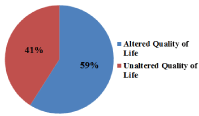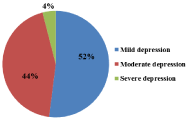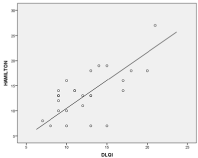Abstract
Background: According to the World Health Organization (WHO), the world prevalence of psoriasis is between 0.9-11.4 % according to the geographical area, in Mexico the prevalence is 2%; the frequency is higher in the Caucasian population, this disease can appear at any age but is more common in the 50- 69 age group. The affectations of the physical, mental and social areas are frequent in this disease.
Aim: The purpose of this study is to know the relationship between depression and quality of life in patients with psoriasis from the family medicine unit #27 (FMU 27).
Design and Setting: Analytic cross-sectional study.
Methods: An analytical cross-sectional study was carried out in patients with psoriasis older than 18 years. Quality of life was measured using the Dermatology Life Quality Index (DLQI) questionnaire and depression using the Hamilton scale. The data was analyzed using the SPSS version 21; the chi-square test was used to determine the association between qualitative variables, the Shapiro-Wilk test was applied for data distribution and correlation using the Spearman test.
Results: 59.3% of the patients have an alteration in the quality of life, 85.2% with depression and a positive correlation between DLQI and Hamilton score.
Conclusion: There is a high prevalence of alterations in quality of life in patients with psoriasis and a high prevalence of depression; The impact on the quality of life is correlated with depression.
Keywords: Psoriasis; Depression; Quality of life
Introduction
Psoriasis is an immune-mediated and genetic disease that occurs in the skin, joints or both [1]. There are different types of psoriasis that vary according to the location and type of lesions, psoriasis vulgaris is the most common presentation where the lesions are well-defined, erythematous and pruritic plaques, the most frequent location is on the trunk, the extensor surfaces of the limbs and skull [2]. Among the triggers of psoriasis are physical or chemical trauma, bacterial infections, mycotic infections, viral infections, smoking, alcoholism and some medications such as systemic corticosteroids, chloroquine, angiotensin converting enzyme inhibitors. One of the best known and little studied factors that is related to the exacerbation of the disease is emotional stress [3].
The WHO defines health as a complete state of physical, mental and social well-being, and not only the absence of diseases or illnesses [4]. For this reason, the adequate quality of life (QoL) of a person is based on reaching that goal or at least being closer to that definition since they are related concepts. In psoriasis there are many questionnaires that evaluate QoL in a patient, the Dermatology Life Quality Index (DLQI) is one of the most widely used [5]. Just as the QoL is affected in the development of Psoriasis, a highly prevalent psychiatric illness in these patients is depression. One of the most widely used instruments to assess the presence of depression is the Hamilton Scale, with a a-Cronbach of 0.7 [6].
It is estimated that the worldwide prevalence of psoriasis is between 0.9-11.4% depending on the geographical area, it is higher in the Caucasian population as in Norway, this disease affects any age, but it is more common in the group of 50 to 69 years. In Mexico, according to the psoriasis clinical practice guide, the prevalence is 2% [7]. Studies of the association between psoriasis and QoL are limited, in Latin America 30% of patients with psoriasis had a mild effect on QoL, 26% a moderate effect and 21% a severe effect [8]. In Mexico there are not many studies that carry out this association, in the city of Puebla, the prevalence was 57% in men and 43% in women with an average age of 51 years, the DLQI was used as an instrument to measure the affectation of quality of life, a higher prevalence of moderate impact on quality of life was found in 33%, 29% small effect, 18% without impact, 16% large effect and only 2.8% very serious effect [9]. In the United Kingdom, a study was carried out in which depression and quality of life were correlated, finding a prevalence of depression of 39%, increasing these percentages according to the severity of the disease in a total of 146,042 patients with psoriasis [10]. The objective of the research was to determine the relationship between depression and quality of life in patients with psoriasis in a primary care center in Tijuana, Mexico.
Material and Methods
Study design and population
An analytical cross-sectional study was carried out at FMU 27 of the Instituto Mexicano del Seguro Social (IMSS), in Tijuana, Baja California, Mexico between January and February 2020. Patients with diagnosis of psoriasis older than 18 years who agreed to participate in the study using informed consent, those with neurological pathology or any condition that prevented compression of the instrument were excluded.
Variables
The collection of variables was done with a standardized data form, the variables were the following: age, sex, occupation and marital status, which were collected directly from the patients. Quality of life was evaluated using the DLQI test, which was validated with a cronbach's alpha of 0.83, it consists of 10 questions, and each item has 4 possible answers according to the Likert scale, taking as a cut-off point a score of 10 to classify the affectation [11]. The diagnosis of depression was made with the Hamilton depression scale, which has 17 items, it has a Cronbach's alpha of 0.7 and the patient was classified according to the score obtained [6].
Statistical analysis
Qualitative variables were expressed in frequencies and percentages, the chi-square test was used to determine the association between dichotomous variables. The quantitative variables as mean and standard deviation; Spearman's correlation test was used to establish correlation between two quantitative variables and the data were analyzed using the SPSS version 21 program, a p-value <0.05 was considered significant.
Results
The study analyzed 27 psoriasis patients with a mean age of 36 years of which 22 are active workers. The predominant sex was female and the marital status was found in its 3 options in almost the same proportion, 37% married, 37% single and 25.9% divorced. We evaluated the quality of life in patients with psoriasis by applying the DLQI (Graphic 1), 59.3% (n=16) had an alteration in the quality of life based on the index obtained, the category of greatest affectation was the area of symptoms and feelings with an average score of 3.7 (maximum 6).

Graphic 1: Quality of life in Psoriasis.
On the Hamilton scale, an average of 13.48 points was obtained, the minimum score was 7 and the maximum 27, at the time of classifying the result 14.8% (n=4) of the patients did not have depression and 85.2% (n=23) have some degree of depression (Graphic 2). It was found that the DLQI and Hamilton variables had a non-normal distribution by the Shapiro-Wilk test (p<0.05), for this reason the Sperman correlation test was applied. The result indicates that there is a positive correlation (Graphic 3) between the presence of altered quality of life and depression (p<0.05 Spearman 0.576).

Graphic 2: Psoriasis and depression.

Graphic 3: Correlation between Hamilton and DLQI test.
Discussion and Conclusion
The quality of life in patients with psoriasis was evaluated by the DLQI instrument, an average score of 12.37 points was obtained, a result similar to a multicenter study in Taiwan by Tsai TF et al (2016), which was 12.55 points [12]; the PSOLAR study included 2076 patients with psoriasis, they found an average of 6 points by applying the same instrument, but most of the patients were on biological treatment [13,14], which improves quality of life. In our population, no patient had this treatment. At the time of dichotomizing the quality of life affectation, 16 patients (59.3%) presented quality of life affectation by having a score greater than 10 in the test and 40.7% did not present alteration, this result is interesting since in multiple studies the quality of life affectation is found in lower percentages, Mejia-Jiménez et al (2018) found that only 21% of the participants had quality of life impairment in a population of 96 patients [8].
In Bogotá Colombia, Cortes et al found a slightly higher percentage (38.9%) of quality of life affectation [15]; in Puebla Mexico Garcia- Sánchez et al (2017) conducted an investigation in 72 patients and of them only 18.8% had quality of life affectations [9]. One of the most important issues to analyze in patients with psoriasis is the prevalence of depression. Multiple studies have found concordance with this type of dermatological disease with a prevalence of 34-39% in studies conducted in the United Kingdom by Tribo et al [16] and Kurd et al [10]. In the FMU 27 population, the frequency of depression was distributed as follows: 85% depression in patients with psoriasis, 52% mild depression, 44% moderate depression and 4% severe.
As conclusion, all our objectives were satisfactorily met; we found a high proportion of patients with quality of life impairment, which could be associated with their type of treatment (topical). Depression in our 27 patients had a high prevalence but most had mild depression; even so, it is necessary to improve the conditions of the disease to reduce the prevalence of depression, since it was found that there is a positive correlation between DLQI and Hamilton.
Ethics
The study was approved by the Local Committee for Ethics and Health Research with registration number R-2020-204-009. The research was carried out under the General Health Law on Health Research, the Declaration of Helsinki and the Bioethical principles. All participants signed the informed consent.
References
- Wolf-Henning B, Schön M. Psoriasis. The lancet. 2015; 386: 983-994.
- Rendon A, Schäkel K. Psoriasis Pathogenesis and Treatment. Int J Mol Sci. 2019; 20: 1475.
- Consenso Nacional de Psoriasis. Guía de Tratamiento. Argentina. 2018.
- Organización Mundial de la Salud. 2019.
- Marcial-Romero N, Peña-Olvera BV, Escobedo-Garrido JS, et al. Elementos objetivos y subjetivos en la calidad de vida de hogares rurales en Yehualtepec, Puebla. Estud Soc. 2016; 26: 1-9.
- Ramos-Brieva JC. Validación de la versión castellana de la escala de Hamilton para la depresión. Actas Luso-Esp Neurol Psiquiatr. 1986; 35: 324- 334.
- Guía de Práctica Clínica. Tratamiento farmacológico para pacientes adultos con psoriasis en placas. México: Instituto Mexicano del Seguro Social; 2013.
- Mejia-Jimenez M, Jimenez-Tamayo SB, Alvaran-Florez L, et al. Calidad de vida y factores psicológicos asociados en una cohorte de pacientes latinoamericanos con psoriasis. Dermatololgia CMQ. 2018; 16: 254-262.
- Garcia-Sanchez L, Montiel-Jarquin AJ, Vazquez-Cruz E, et al. Calidad de vida en el paciente con psoriasis. Gac Med Mex. 2017; 153: 185-189.
- Kurd SK, Troxel AB, Crits-Christoph P, et al. The risk of depression, anxiety and suicidality in patients with psoriasis: a population-based cohort study. Arch Dermatol. 2010; 146: 891-895.
- Restrepo C, Escobar-Valencia C, Mejia-Giraldo AM. Instrumentos de evaluación de la calidad de vida en dermatología. IATREIA. 2013; 26: 467- 475.
- Tsai TF, Ho JC, Chen YJ, et al. Health-related quality of life among patients with moderate to severe plaque psoriasis in Taiwan. Dermatológica Sinica. 2018; 36: 190-195.
- Pappa KA, Strober B, Augustin M, et al. PSOLAR: design, utility and preliminary results of a prospective, international, disease-based registry of patients with psoriasis who are receiving, or are candidates for conventional systemic tratments or biologic agents. J Drugs Dermatol. 2012; 11: 1210- 1217.
- Strober BE, Bissonnette R, Fiorentino D, et al. Comparative effectiveness of biologic agents for the treatment of psoriasis in a real world setting: Results from a large, prospective, observational study (Psoriasis Longitudinal Assessment and Registry [PSOLAR]). J am acad dermatol. 2016; 74: 851- 861.
- Cortés C, Castro-Ayarza JR, Fieero E, et al. Calidad de vida de pacientes con psoriasis en un hospital de tercer nivel. Comunicación de 59 casos. Dermatología Rev Mex. 2010; 54: 125-132.
- Tribó M, Turroja M, Castaño-Vinyals G, Bulbena A, Ros E, García-Martínez P, et al. Patients with Moderate to Severe Psoriasis Associate with Higher Risk of Depression and Anxiety Symptoms: Results of a Multivariate Study of 300 Spanish Individuals with Psoriasis. Acta Derma Venereolo. 2019; 99: 1-9.
